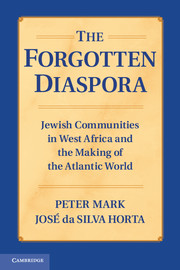Book contents
- Frontmatter
- Contents
- List of Illustrations
- Acknowledgments
- Introduction
- 1 Two Sephardic Communities on Senegal's Petite Côte
- 2 Jewish Identity in Senegambia
- 3 Religious Interaction
- 4 The Blade Weapons Trade in Seventeenth-Century West Africa
- 5 The Luso-African Ivories as Historical Source for the Weapons Trade and for the Jewish Presence in Guinea of Cape Verde
- 6 The Later Years
- Conclusion
- Appendix I The Jewish Traders of Porto d'Ale and Joal, Their Relatives, and Some of Their New Christian Partners in Senegambia and in the United Provinces and Portugal: A Comprehensive List (ca. 1606–ca. 1635)
- Appendix II A Chronological Outline of the Institutional Proceedings against the Jews of Porto d'Ale and Joal (1611–1643)
- Bibliography
- Index
3 - Religious Interaction
Catholics, Jews, and Muslims in Early Seventeenth-Century Upper Guinea
Published online by Cambridge University Press: 03 May 2011
- Frontmatter
- Contents
- List of Illustrations
- Acknowledgments
- Introduction
- 1 Two Sephardic Communities on Senegal's Petite Côte
- 2 Jewish Identity in Senegambia
- 3 Religious Interaction
- 4 The Blade Weapons Trade in Seventeenth-Century West Africa
- 5 The Luso-African Ivories as Historical Source for the Weapons Trade and for the Jewish Presence in Guinea of Cape Verde
- 6 The Later Years
- Conclusion
- Appendix I The Jewish Traders of Porto d'Ale and Joal, Their Relatives, and Some of Their New Christian Partners in Senegambia and in the United Provinces and Portugal: A Comprehensive List (ca. 1606–ca. 1635)
- Appendix II A Chronological Outline of the Institutional Proceedings against the Jews of Porto d'Ale and Joal (1611–1643)
- Bibliography
- Index
Summary
“Disserão ao rei que nós os católicos … adoravamos em pedras e em paus.”
The Jews of the Petite Côte were protected from representatives of the Inquisition by the local Wolof and Sereer elite who were, in large part, Muslims. The historical context of Jewish-Muslim relations in the century following the expulsion or forced conversion of Iberian Jews sheds light on the relations that developed between the Jews of Senegal's Petite Côte, and the neighboring Muslim rulers. The long passage written around 1608 by Sebastião Fernandes Cação, cited in Chapter 1, clearly indicates that the Jews of Porto d'Ale enjoyed a measure of protection against Portuguese Christians.
The Senegalese ruler who took the side of the Jews was the Teigne, or Teeñ, the Wolof leader of the state known as Baol. He was a Muslim. It was clearly in his economic self-interest to welcome the newly established Jewish merchants. With their ties to Holland, these men provided competition for the Portuguese and Luso-African merchants based in the Cape Verde Islands and at Cacheu, located in northern present-day Guinea-Bissau about 200 kilometers south of the Petite Côte, and also for the English and the French who, sometimes with the help of the lançados and Luso-Africans, traded in the king's land. Nevertheless, one wonders whether something more was at issue. Was this ruler consciously following Muslim law, by extending protected or dhimmi status to the Jews who had settled on or adjacent to his territory?
- Type
- Chapter
- Information
- The Forgotten DiasporaJewish Communities in West Africa and the Making of the Atlantic World, pp. 83 - 102Publisher: Cambridge University PressPrint publication year: 2011



